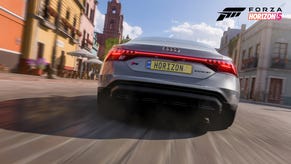How Forza Horizon 5 scales across the console generations
And what to expect from the 60fps performance mode.
For Digital Foundry, this was one of the biggest highlights of this year's Xbox E3 showcase - and quite possibly, the show as a whole. No CG trailers, no empty title announcements, but real meat: an authentic in-game showcase demonstrating that Playground Games is set to deliver a true next-gen driving experience for Xbox Series consoles and suitably equipped PCs - and we don't have that long to wait either: we'll be playing Forza Horizon 5 from November 22nd this year.
However, despite delivering a beautiful next-gen showcase in its presentation, the truth is that Forza Horizon 5 is a game set to straddle the generations. The demo we saw was clearly leveraging the horsepower and storage prowess of the new wave of gaming hardware, but there's going to be an Xbox One version too - set to run at 1080p30 no less, just like prior Forza Horizon titles. Looking at the material we've seen so far, it scarcely seems possible, but it's definitely happening.
Quite how Playground looks set to deliver this hasn't been fully laid out - though in today's big Forza Horizon 5 interview, the game's creative director, Mike Brown, tells Eurogamer's Oli Welsh that "since Horizon 3, we have already been on PC, and that means that we're already used to delivering a game on a whole range of system specifications. So having to have the game work on Xbox One, Xbox Series consoles, PC, it isn't that different. I think having to support the Xbox One consoles is exactly the same amount of effort as it is to support a lower spec PC. We're actually feeling pretty great about all versions of the game, to be honest."
The question of scalability doesn't just extend to cross-generational concerns. Initial PR for the game also indicated that the game would run at 4K30 on Xbox Series X with a 60fps performance mode, with no mention of how the game would adapt to deliver twice the performance. The lack of a pixel count metric would suggest a lower resolution would be required to run at 60fps - a trade of pixels for frames, if you like. However, that assumption was blown out of the water when Mike Brown took to Twitter, proclaiming that "Performance mode gets you 4k60 on Series X and 1080p60 on Series S."
So we've got two questions here to discuss regarding scalability - how on earth Playground can get a game looking that good running at all on a vintage 2013 Xbox One, while at the same time considering how the studio is set to deliver a 60fps performance mode that seemingly runs at the same resolution as the quality mode. We asked Microsoft for comment and got some interesting information back, some added context to Mike Brown's tweet: "While Forza Horizon 5 was built to showcase the abilities of X|S consoles, in order to provide best-in-class experiences on a wide range of PCs as well as Xbox One, we've invested in a number of scalable technologies, such as dynamic resolution scaling (DRS), variable draw distances, and a robust levels of detail (LOD) system."
And in terms of further clarification, we got some more details on how scalability works between the quality and performance modes: "Forza Horizon 5 runs at 4K/30fps on Xbox Series X and 1080p/30fps on Xbox Series S. For players that prefer to optimise for frame-rate, we'll have a performance mode option that will run at 4K/60fps with select graphical features scaled to maintain a steady frame-rate on Xbox Series X and 1080p/60fps on Xbox Series S."
There's some interesting information to dissect here. First of all, we can rule out the approach taken to supporting last-gen systems as seen in Forza Horizon 2, which launched on both Xbox One and Xbox 360 in September 2014. The approach there was to farm out development of the last-gen version to an external developer (in that case, Sumo Digital) who essentially based its pared back rendition of the game on the existing Xbox 360 engine used for the original Horizon. In the case of FH5, Playground has built on the scalability required to get its games running on low-spec PCs in order to facilitate Xbox One and One X versions.
In building on this foundation, it looks like the studio is expanding how scalable the engine is. To the best of our knowledge, dynamic resolution scaling has never been a part of ForzaTech - Turn 10 and Playground have doubled down on native resolution in delivering the pristine presentations that are a core part of the series aesthetic. DRS seems to be a new feature available in the toolbox. However, if dynamic resolution isn't deployed for the performance modes on Series consoles - if resolution remains static, as suggested here - we now have some idea of how the studio aims to deliver the performance modes. It does raise the question of whether there might be a third way forward though - to retain the full suite of quality mode visual features and drop back resolution instead, if that's possible. It'll be interesting to see how Playground chooses to proceed in the final months of development.
Regardless, in common with prior Forza titles, it's likely the case that PC will allow for that level of customisation in the experience, with 4K60 and all the trimmings reserved only for the most high-end of hardware. There's certainly much to look forward to, though. The new Mexico environment delivers a level of granularity in detail that definitely looks next-gen in nature. The quality of the photogrammetry materials, the phenomenal skyboxes and dynamic weather conditions look a world apart from prior Horizon titles and having recently returned to FH4, that game still looks first class. We were also deeply impressed with the global illumination system and the lingering vista shots we see before the player vehicle speeds into view before segueing seamlessly into gameplay - almost as if Playground wants to demonstrate that this new level of fidelity really is running in real-time. Exciting times ahead, and we're really looking forward to taking a much closer look at the game.











